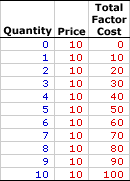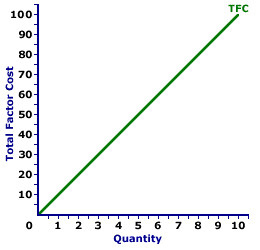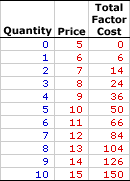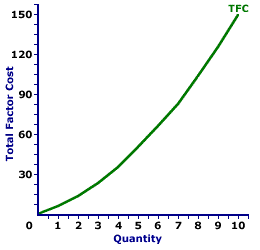
|
|
KONDRATIEFF CYCLE: A cycle of economic activity lasting between 45 and 60 years that acquired the name of the first economist to study it, the Russian economist N. D. Kondratieff. The Kondratieff cycle is somewhat controversial and has been attributed to a number of different causes, including investment in transportation infrastructure. This is one of four separate cycles of macroeconomic activity that have been documented or hypothesized. The other three are Kitchin cycle, Juglar cycle, and Kuznets cycle.
Visit the GLOSS*arama
|
|


|

|
                           TOTAL FACTOR COST: The opportunity cost incurred when using a given factor of production to produce a good or service. This is the total cost associated with the use of a particular resource or factor of production--it is the total cost of the factor. Total factor cost is predominately used in the analysis of the factor market. Two derivative factor cost measures are average factor cost and marginal factor cost. Total factor cost is the total opportunity cost incurred by a firm from the employment of a given resource. This measure of cost needs to be contrasted with a similar, better known term, total cost. Total cost is the cost of all factors of production, whereas total factor cost is the cost of using a specific factor. Total cost, as such, is the sum of the total factor cost of labor, the total factor cost of capital, and the total factor cost of all other inputs. Total factor cost can be represented in a table or as a curve. For a firm with no market control hiring inputs under perfect competition, the total factor cost curve is a straight line that emerges from the origin. For firms with market control, including monopsony, oligopsony, or monopsonistic competition, the total factor cost curve increases at an increasing rate. The shape of the total factor cost curve thus indicates the degree of market control possessed by the factor buyer. Whichever market structure is involved, total factor cost is calculated as the factor price times the quantity of the factor purchased, as illustrated by this equation: | total factor cost | = | factor price | x | factor quantity |
If the firm is hiring the factor in a perfectly competitive factor market, then the factor price is fixed or constant and total factor cost increases at a constant rate. If the firm is hiring the factor in an imperfectly competitive factor market, best illustrated by monopsony, then the factor price increases with larger factor quantities and the total factor cost increases at an increasing rate. Perfect CompetitionThe basics of total factor cost can be illustrated by perfect competition. Perfect competition is a market structure with a large number of small participants (buyers and sellers). The good exchanged in the market is identical, regardless of who sells or who buys. Participants have perfect knowledge and perfect mobility into and out of the market. These conditions mean perfectly competitive buyers are price takers, they have no market control and must pay the going market price for all inputs bought.Total Factor Cost,
Perfect Competition |  |
The table to the right summarizes the total factor cost incurred by a hypothetical buyer, Aggie's Macrame Shoppe, for hiring store clerks in a perfectly competitive labor market. Maggie's Macrame Shoppe is one of thousands of small retail stores in the greater Shady Valley metropolitan area that hires labor with identical skills. As such, Maggie pays the going wage for labor.The first column in the table is the quantity of workers hired, ranging from 0 to 10 workers. The second column is the price Maggie pays for hiring her workers, which is constant at $10 per worker. The third column is then the total factor cost Maggie incurs for hiring various numbers of workers. If Maggie hires only one worker, then she pays only $10. If she hires five workers, she pays $50. In each case, total factor cost in column three is calculated as the quantity in the first column multiplied by the price in the second column. Consider a few highlights of these total factor cost numbers. - First, total factor cost is zero if Maggie hires no workers. This makes sense. If nothing is bought, no cost is incurred.
- Second, the price remains unchanged. Maggie can hire 1 worker or 10 workers for the same $10 wage. Presumably, if Maggie hired 100 workers, the wage remains at $10.
- Third, as Maggie hires more workers she incurs more total factor cost.
- Fourth and last, for each extra worker Maggie hires, she pays an extra $10 of cost. This suggests an important role for marginal factor cost in the factor market analysis of a perfectly competitive firm.
Total Factor Cost Curve,
Perfect Competition |  |
Total factor cost is commonly represented by a total factor cost curve, such as the one displayed in the exhibit to the right. This particular total factor cost curve is that for labor hired by Maggie's Macrame Shoppe. The vertical axis measures total factor cost and the horizontal axis measures the quantity of input (workers). Although quantity on this particular graph stops at 10 workers, the nature of perfect competition indicates it could go higher. This curve indicates that if Maggie hires 1 worker, then she pays $10 of total factor cost. Alternatively, if she hires 10 workers, then she pays $100 of total factor cost. Should she hire 100 workers, then she would move well beyond the graph, with $1000 of total factor cost. The "curve" is actually a "straight line" because Maggie is a price taker in the labor market. She pays $10 for each worker whether she hires 1 worker or 10 workers. The constant price is what makes Maggie's total factor cost curve a straight line, and which indicates that Maggie has no market control. Monopsony, Oligopsony, and Monopsonistic CompetitionFor market structures like monopsony, oligopsony, and monopsonistic competition that have some degree of market control and are price makers rather than price takers, total factor cost is little different. Although total factor cost is also calculated as price times quantity, market control means these market structures face positively-sloped supply curves. As such, the price received is not fixed, but depends on the quantity of the input bought.Total Factor Cost,
Monopsony |  |
The table to the right summarizes the total factor cost received by another hypothetical firm, OmniKing Island Resort. This firm is the only employer of labor on a small tropical island. As the only employer of labor on the Island, OmniKing is a monopsony with extensive market control, and it faces a positively-sloped supply curve. To employ more workers, OmniKing must pay a higher price.Consider a few tidbits of information about total factor cost for a firm with market control, such as OmniKing Island Resort. - First, like perfect competition, total factor cost is zero if OmniKing hires no labor. This makes sense. If nothing is bought, no factor cost is incurred.
- Second, the price changes with the quantity of output bought. OmniKing can hire 1 worker for $6. However, if it choses to hire 5 workers, then it must raise the price to $10.
- Third, as OmniKing hires more labor it pays more total factor cost.
- Fourth and last, unlike perfect competition, the extra factor cost incurred from hiring more labor is not constant nor is it equal to the price. For example, the fifth worker adds a extra $14 to factor cost (the difference between $50 and $36) even though the price is $10.
Total Factor Cost Curve,
Monopsony |  |
The total factor cost curve for firms with market control looks a little different than that for perfect competition. The total factor cost curve for OmniKing Island Resort is displayed in the exhibit to the right. Key to this curve is that OmniKing is a monopsony buyer of workers and thus faces a positively-sloped supply curve. Larger quantities of input can be had only with higher prices.The vertical axis measures total factor cost and the horizontal axis measures the quantity of input (workers). Although quantity on this particular graph stops at 10 workers, it could go higher. This curve indicates that if OmniKing hires 1 worker (at $6 per worker), then it pays $6 of total factor cost. Alternatively, if it hires 10 workers (at $15 per worker), then it pays $150 of total factor cost. For OmniKing the total factor cost "curve" really is a "curve." The slope of this curve rises as more labor is hired. The changing slope of this curve is due to the changing price. Although this total factor cost curve is based on the employment activity of OmniKing Island Resort, a well-known monopsony firm, it applies to any buyer with market control. Monopsonistic competition and oligopsony firms that also face positively-sloped supply curves generate comparable total factor cost curves.

Recommended Citation:TOTAL FACTOR COST, AmosWEB Encyclonomic WEB*pedia, http://www.AmosWEB.com, AmosWEB LLC, 2000-2025. [Accessed: July 18, 2025].
Check Out These Related Terms... | | | | | | | | |
Or For A Little Background... | | | | | | | | | | | |
And For Further Study... | | | | | | | | |
Search Again?
Back to the WEB*pedia
|



|

|
ORANGE REBELOON
[What's This?]
Today, you are likely to spend a great deal of time wandering around the downtown area trying to buy either shoe laces for your snow boots or a rim for your spare tire. Be on the lookout for the happiest person in the room.
Your Complete Scope
This isn't me! What am I?
|

|
|
The standard "debt" notation I.O.U. does not mean "I owe you," but actually stands for "I owe unto..."
|

|
|
"A winner is someone who recognizes his God-given talents, works his tail off to develop them into skills, and uses those skills to accomplish his goals. " -- Larry Bird, basketball player
|

|
NZFOE
New Zealand Futures and Options Exchange
|

|
|
Tell us what you think about AmosWEB. Like what you see? Have suggestions for improvements? Let us know. Click the User Feedback link.
User Feedback
|


|


